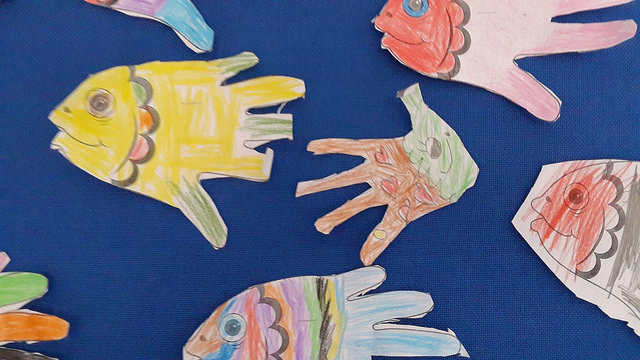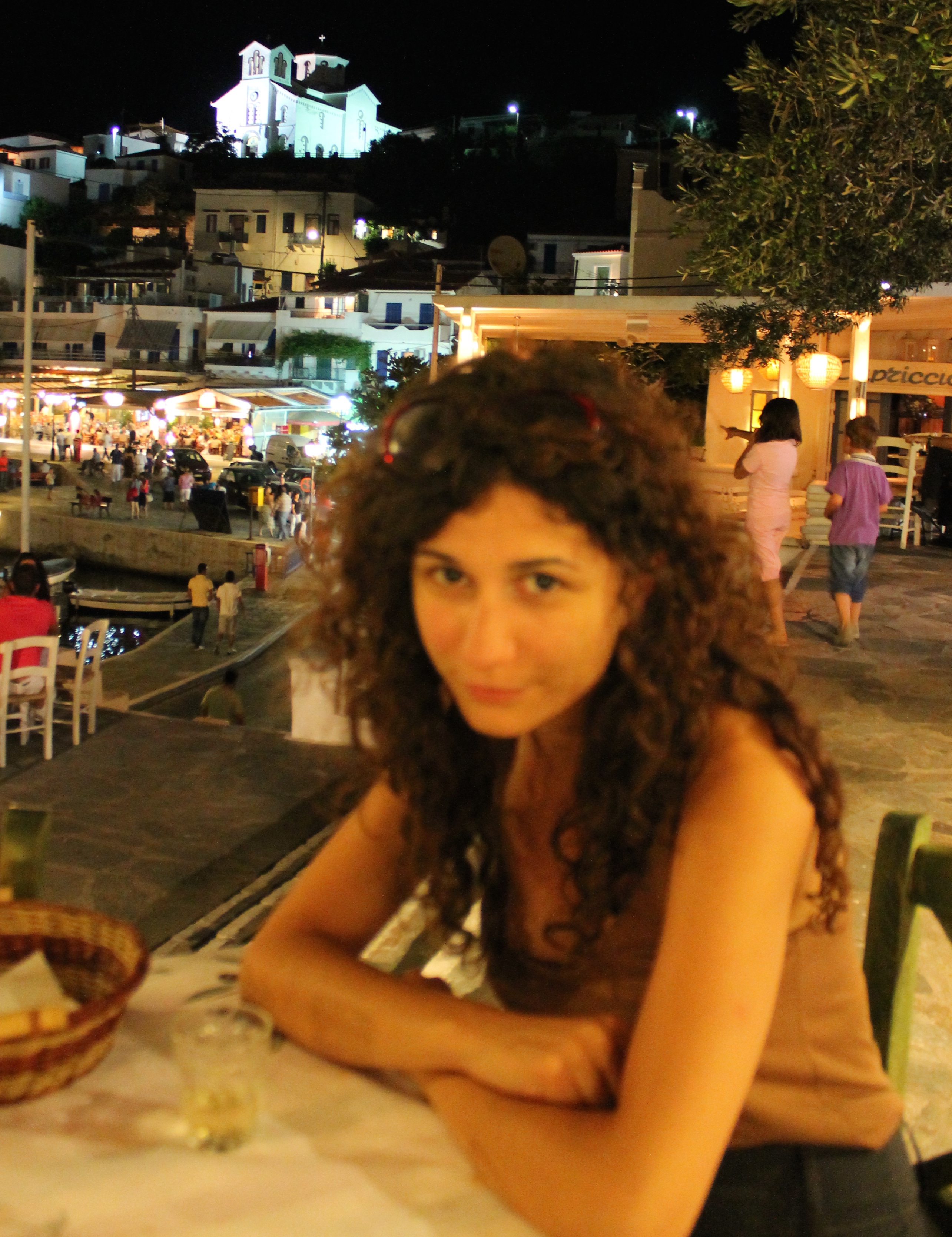Theme Essay by Ioanna Pettas Opidee
Finding Ballast as a Teacher-Writer

The second hand on my alarm clock ticked closer to 7:00. Soon it would blast, though I hadn’t yet fallen asleep. I sat on my bed, above the covers, hunched over a thick stack of student essays with my roommate’s dog and cat beside me. Just a few more papers…if I can finish these last three…where’s the damn thesis statement?!
As a 21-year-old graduate student, I was in my first year of teaching, with an assistantship that gave me roughly fifty freshman students in two sections of composition. Two weeks before the semester began, I was handed the book for the class and told by a second-year grad student that it was a “sink or swim” situation, so I’d better get ready to swim. What I wasn’t handed was far more crucial advice about the need to take care of myself.
I’d been up long past midnight, first finishing a twenty-page story for my fiction workshop with stoic determination, as if it were a middle-school book report—then moving on to the fifty papers I had to grade in time for my eight a.m. class. By four a.m., I’d determined that sleep was no longer an option.
Of course, it was I who decided the students had to have their papers back two days after turning them in. And it was I who’d developed a habit of writing margin notes roughly as long as the essays themselves.
I finished grading around seven and climbed into the bathtub. With the hot water showering down and the drain closed shut, I leaned my head back on the porcelain. I’ll stand when the water reaches halfway up my legs. I’ll just lie here for a minute and rest my eyes.
But as the waterline neared my kneecaps, I jerked awake from a hypnotic slumber. I gripped the side of the tub and attempted to stand, my vision blurred, and I felt myself falling, spiraling down like water in the drain, Alice in the rabbit hole, the universe into a black hole, in slow motion—the world a swirl of pink and white.
My head smashed onto the porcelain and bounced off the right side of the tub, then the left. My backside slipped under me, and I lay flat. My hand touched my forehead, touched blood. How do I make it to class now?
My roommate wasn’t home; her cat and dog could only eye me from the open doorway, whining in sympathy. I climbed over the edge of the tub and collapsed onto the bathmat, trying to slow the spinning. Stand up, get dressed, and drive. Even in my confused state, I realized this was not the best choice. Call Brooke.
When Brooke arrived soon after, my classmate and friend from down the road took one look at my wounded face and said, “Oh, God. You are not going to teach like that.”
“I have to. They need their papers back in time to revise for Tuesday.”
This was our language, so I knew Brooke would understand; she had a similar devotion to the job. But she only said, “You’re cancelling your class.”
“I can’t! It’s too late!”
“You need stitches.”
“Brooke, I can’t. Please, just take me to school?”
Reluctantly, she complied. When I reached my class, still dazed by the drama—and head trauma—I apologized to my students for the large bandage on my forehead and told them an abridged version of the story, laughing a little to show they could, too.
They just stared at me. No one laughed. “You know, Miss Pettas,” one young man said, “you may need to see a doctor.”
“Nah, I’m fine,” I replied, even as I realized that, with each passing moment, I was reinforcing any notions of my insanity they might have—that most students have about professors—or about anyone willing to devote so much thought and time to one subject.
“Maybe we’ll end a bit early,” I said calmly, despite my throbbing brow.
• • •
After class, I didn’t go to the doctor, as perhaps I should have. But I also didn’t linger in the graduate assistant office or plan for the next day’s class or work on my critical analysis of Henry James’s The Ambassadors or whatever else I had to do for my own coursework.
Instead, I went to the beach. I put on my headphones and listened to music. I soaked in the sun. I walked along the shore and let the wet sand swallow my feet. I communed with the seagulls and the waves; I let my mind wander and drift; I wrote in a journal. I swam.
And through all this, I began to remember what I was doing and why: I wanted to write. I wanted to teach writing because I believed in its power and value for everyone, but most especially for myself. After that day, I took regular sojourns to the shore. I considered it an essential part of my work, a duty, an obligation.
I still do. No matter how much I care about and feel obligated to my students, I need space. I need room for mental wandering, for compression and decompression of my ideas, emotions, and notions. If I don’t take this need seriously, I have no ballast to stop the flood of teaching demands from washing away my writing self.
• • •
Now, about ten years into my teaching life, I think of this sink-or-swim story often. I retell it often, especially to new, simpatico teachers who wonder if they’re working too hard or hard enough. I tell this story in which I both sank and swam—to help newer teachers feel normal. As long as you don’t walk into your classroom gushing blood, you’re okay.
It’s a cautionary tale, but also a recognition of what it feels like to fall in love with teaching. It’s an extreme example of caring so deeply about your students and their work that you abandon all sense of self beyond your teacherly identity. It doesn’t last forever, I usually add. Eventually, you regain a sort of center.
It’s not really a victory story, though, because I still struggle with this constantly. I often find myself metaphorically passing out in the bathtub and requiring stitches, as I meet for hours on end with students, staying up all night writing paragraphs of feedback on minor assignments or searching for the absolutely perfect reading to add to our syllabus.
While teachers are often lauded for their selflessness, as a teacher, it’s hard to know where my own center is—how much to give, how much to expect to receive, and whether or not the teaching-learning process should be thought of in those terms at all. It’s not really about giving and receiving so much as doing and sharing.
There’s no end to the amount of work that can be put into teaching. There’s always more to do, but there’s also a point at which a teacher does too much, thereby unwittingly stunting students’ development of their own agency. Finding ballast as a teacher is not just about the practice of being a writer; it's also about being a better writing teacher—helping students learn to take risks, to rely more on themselves as sources of inspiration and guidance. For the teacher, this demands a flexible approach of intervention and withdrawal.
Sometimes, students need a highly specific prompt or assignment; other times, they benefit from an open-ended invitation to pursue their own inclinations. Some students need to be directed toward a helpful reading or specific aspects of a text; others get more out of an assignment if they make these discoveries themselves.
A healthy state of ballast, then, gives me permission as a teacher not to work too hard. Rather than hovering over students in unproductive ways, I can decide whether extensive written feedback will help or hinder their progress on a given draft. These days, I try to remember that being a good teacher of writing means a lot more than getting students’ drafts back to them with copious margin notes; it means more than having handouts photocopied three weeks in advance.
Every once in awhile, I need a radical reminder that I’m a writer and that my writing is real work—and my students need this reminder as well. My writing is, to a great extent, what qualifies me to teach. The energy I bring into the classroom after thirty minutes of writing is often more powerful than hours spent jotting feedback on student papers.
I am a professor because this I can profess—that writing allows me to make, discover, and investigate truth and meaning. It lets me attend to the mind, which is too often fractured and fraught, and to communicate one-on-one with other human beings in a society that’s become virtually connected even as individuals grow farther apart.
What my students need most is living testimony to the value of writing. By living—as well as professing—to my ideals, I believe they experience the power of the writing life firsthand, even if the evidence isn’t always happy or good or blood-free.
Art Information
- "Handprint Fish" © Denise Krebs; Creative Commons license.
 Ioanna Opidee taught college writing and literature courses for ten years at various institutions, most recently at Fairfield University in Fairfield, Connecticut, before becoming a high school English teacher in 2015. Her work has been published in several magazines, journals, and online publications, including Drunken Boat, Lumina, the Huffington Post, and Assay: A Journal of Nonfiction Studies.
Ioanna Opidee taught college writing and literature courses for ten years at various institutions, most recently at Fairfield University in Fairfield, Connecticut, before becoming a high school English teacher in 2015. Her work has been published in several magazines, journals, and online publications, including Drunken Boat, Lumina, the Huffington Post, and Assay: A Journal of Nonfiction Studies.
